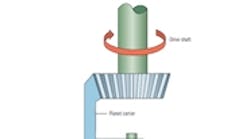Planetary gears are predominantly associated with in-line reducers. But planetary bevel gearing – commonly used to drive the rear wheels in cars – go in a different direction.
The automobile differential involves planet gears and a planet carrier, but the gear motion becomes epicyclic only when compensating for a speed difference between the left and right wheels.
The planet carrier is the large disk-shaped bevel gear with inward-facing teeth. When the driveshaft turns, the carrier performs a right-angle reduction as it revolves the planet gears, which in turn mesh with “sun” and “ring” bevel gears corresponding to the left and right side of the axle. As long as the rear wheels turn at equal speed (straightahead vehicle motion) the planetary gears remain interlocked with the axle gears – the planetaries do not turn on their axes, and carrier rotation correlates exactly with that of the left and right wheels. An in-line planetary analogy would be something like a rotating planet carrier driving a sun and ring gear with the planet gears welded to their pins. The sun and ring output are comparable to two car wheels and, along with the carrier, turn at the same rate.
When one of the wheels has to move at a different rate, however, the planetary bevels begin to spin on their axes as they revolve with the carrier. This amounts to epicyclic motion. Thanks to the bevel-gear differential, automobiles are able to corner without skidding the tires.
The basic automobile differential distributes driving torque equally between the two wheels. This can be a problem when, say, one wheel rests on ice and the other wheel encounters pavement. Since the low-friction wheel can turn freely with almost no torque, it spins alone, uselessly (at twice the speed as when both wheels move together under the same input) while the other stationary wheel is delivered equal but insufficient torque. That’s why traction-restoring arrangements are used, such as in the familiar limited-slip differential.

